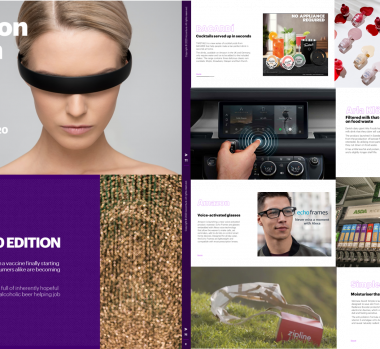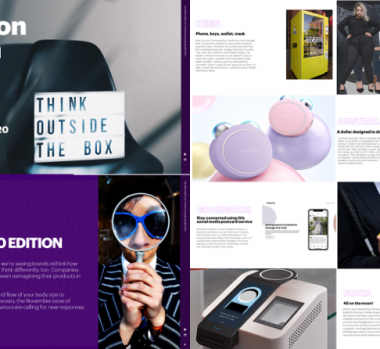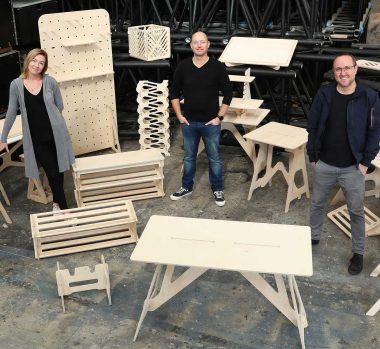Experiment Engines: The Key to Unlocking Cultural Agility
They want to retain their scale benefits but somehow flick a switch with the workforce so they think like a customer, take more responsibility, work collaboratively and do not let history rule decision making. The need for this kind of agile corporate transformation has never been greater as almost every large incumbent is facing competition from younger, more nimble challengers. Just as a ‘test and learn’ approach can quickly develop new customer offers, Experimentation is a powerful way to shift culture in large organisations.
Little has been spoken about on this topic to date and in this article we share an approach that frankly has surprised us in its ability to create change. We think this is a radical and practical alternative to traditional change management – something that in our opinion is way too long on analysis, too top down and the waterfall project management approach is much too slow. CEOs, HR and L&D leaders aspiring to agility at scale should know our ‘Experiment Engine’ approach is not only effective but can be piloted and scaled-up at relatively low cost.
The concept of ‘corporate culture’ is too complex-a-concept for leaders to engage with effectively, at least in the short term. There are simply too many moving parts, many of which are beyond a leader’s control. The most effective level of abstraction is to focus on an individual’s behaviour. Make changes here and an individual can affect their cohort, and many cohorts can have organisational impact. If the individual is a leader, or has followers, then the impact is magnified.
Up until now shifting behaviour has often been the preserve of eye wateringly dull change programmes. Leaders over invest in designing purpose, vision and values statements. These thinking exercises are launched with great acclaim but invariably land poorly in the organisation. Middle and senior managers resent stuffy exhortations to ‘trust’ or ‘collaboration’. These behavioural diktats are distasteful to many.
Let’s take a look at some experiments designed to shift the behaviour of individuals and small teams, and then we’ll look at how these can scale up.
Experimenting with Agility
- Working with a large energy company we trained senior and middle managers to experiment with a limited number of their values, one of which was ‘trust’. What would they do differently if they experimented by dialling up ‘trust’ to an almost extreme degree? The hypothesis of one group was that they could make many more decisions independent of their boss. The cohort set about ‘trusting’ each other on steroids and made almost all decisions themselves rather than ‘referring them up’. After three fortnightly cycles of Experimenting with ‘dialled up trust’ they learnt that in almost all cases they made the same decision as their boss would have made. As a result, decision rights were reorganised and the group has revolutionised the time it takes to accomplish most tasks.
- Similarly we worked with a global financial services company that wanted it’s people to work with greater pace. This time we trained a number of lead Experimenters, or ‘Champions’ how to Experiment. With our help they each gathered a small group of colleagues and explored the daily activities that slowed them down. One group responsible for recruitment hypothesised that they could cut several approval layers before making a hire. After double checking that they did indeed have permission to do things differently, their first Experiment was to bypass a couple of layers. Another group felt the office layout was too formal and encouraged hideaway working. They chose to Experiment by creating a ‘standing meeting room’ and introducing an afternoon tea and cake break. Both groups found that not everything they did worked well but after several rounds of Experimenting they were able to demonstrate that the slimline recruitment process and collaborative office environment had real behavioural benefits. They did this in just a few weeks, far faster than if they had attended meetings to think it through.
In these examples colleagues liked getting on and trying something out rather than thinking too hard about it beforehand. They talk about it as ‘being bold in a safe way’. Not only is this a welcome relief for those burdened with bureaucracy and compliance but unbridled ‘doing’ as opposed to fettered ‘thinking’ delivers more audacious outcomes. Experimenters often comment at how surprisingly ‘brave’ they have been.
They talk about it as ‘being bold in a safe way’. Not only is this a welcome relief for those burdened with bureaucracy and compliance, but unbridled ‘doing’ as opposed to fettered ‘thinking’ delivers more audacious outcomes.
Typically an Experiment such as those described above can take a couple of weeks to set up. During this time the leader of the Experiment (the Champion) is working with their boss to ensure the Experiment is tackling a suitable challenge (more on that later). The challenge, or hypothesis, is all the better if it is something the Champion and their team are really passionate about. They line up their group of fellow Experimenters (ideally no more than ten strong) and ensure their boss really has given permission to try something new. A Champion usually needs training in the skills of designing and managing an Experiment which we do over a couple of days. Then the Champion gets their team together and plans the Experiment which normally takes the form of three or four two-week cycles. Each cycle sees the team working autonomously with customers or colleagues to share, get feedback and refine their hypothesis. This might be done online, in meetings or out of the office in the environment in which decisions are made. We find that it’s not practical to expect Experiment teams to drop their day jobs and focus full time. Nor will anyone appreciate another new management idea that adds to their to-do list. This is why it’s important to select non-additive challenges and set expectations that no more than a day a week may be spent Experimenting. After each cycle the team reviews its learnings and has an opportunity to revise the hypothesis, or to ‘pivot’. Finally an Experiment has a wash-up meeting where decisions are made about next steps.
But running a few pilot experiments is one thing, affecting deeper change with thousands of colleagues is quite another.
The Power Of Envy
Remember the iconic scene in the film ‘When Harry Met Sally’? The one where the lady in the diner says ‘I’ll have what she’s having’? That’s how an Experiment Engine is built. People want the success and enjoyment others are having. Envy is the most natural and powerful change management tool.
‘Envy is the most natural and powerful change management tool.’
An Experiment Engine cannot be built through situation analysis, programme design, announcement and then roll out. Instead we do whatever it takes to create Experimental ways of working that have broad-based appeal. We want onlookers to feel green with envy.
Having ‘Envy’ as our deployment mantra means:
- All our focus is on colleagues, they’re our customer. Understanding their relationship with the organisation, their bosses and peers, is critical.
- Tone is important. An Experiment Engine is a deliberately humanised approach to business. As such, the communication style can feel insufficiently serious to some leaders. However, choosing to Experiment with a formal or corporate tone and style is a big mistake.
- Experiments work with volunteers not victims. We don’t force Experimentation on anyone. This way we’re more confident of building a community of believers and persuasive advocates and so more readily able to reach a tipping point. Again, for leaders, the challenges of ‘Going With The Love’, as we call it, can be considerable.
- All Experiments start quietly, there are no announcements. We want the output to do the talking. Whilst this covert, almost renegade style of work is attractive to many, some leaders can find the ambiguity and informaility hard to swallow.
‘An Experiment Engine is a deliberately humanised approach to business but the communication style can feel insufficiently serious to some leaders. Choosing to experiment with a formal tone and style though, is a big mistake.’
So practically, how do you create Envy?
1. Make it Personal
A programme of Experimentation that smells just slightly corporate will fail. Experiments need to be felt at a personal level. Because Experimentation embraces that which is half-finished, it’s bias to action, and simple common sense ‘human’ appeal means it doesn’t sound like a traditional business tool. Paradoxically this is why it is so welcomed in business.
Experimenters first translate a personal passion into a hypothesis, then they test it out. If their hypothesis was wrong they need the humility to recognise that. It doesn’t get more personal, and occasionally tense, than this. Psychologists will tell you that this is a very good learning environment.
The benefits of Experimenting are often reported as personal benefits. We believe this is critical to scale adoption. This is how we hear people express typical benefits: “I felt trusted”, “My inner entrepreneur came out”, “Finally I feel really useful around here” and “I’ve made my week so much more effective”.
Experiments are also highly motivating to millennial talent. Experiments thrive on strong opinions about righting wrongs. They can be heady experiences where the search for the truth and the strength of character is paramount. There is no room for hierarchy, presenteeism or clever comments. (Sadly, from the way I make these comments you can see I am not a millennial).
Get Experiments right and the personal rewards are so high that there is no need to reward Experimenters with additional compensation.
2. Make Life Easier
Experiments need to be simple and non-additive. This is because we want the Experimenter to get confident Experimenting and not spend their time sweating over the problem. We need them to feel the output is really useful; that’s why we ask people to focus on Experimenting around challenges on their ‘to-do’ list and not their wish list.
Also, most people at work feel they are running at 110% so making their to-do list shorter, easier to manage or just more enjoyable is something that is deeply appreciated.
It’s also worth noting that Experiments reduce ‘managing upwards’. Preparing endless decks for leaders is felt very personally by many. We have found that by engaging senior leaders in an Experiment, those leaders quickly become vested in the learning journey and switch from sceptics to supporters. Now they want to take part in the experience rather than demand reading material.
‘Experiments need to be simple and non-additive.’
3. No Big Tah-dah
We don’t advertise the fact that an organisation is hell bent on reinventing itself as an Experiment Engine. So many corporate initiatives are badly handled that almost any big announcement is destined to fail. Instead we ban the use of PowerPoint and harvest the results of Experimenting as short stories. We ask Experimenters to record everything on their smartphones (having given permission). We use expert videographers to refine the content into powerful two minute films that tell the story 15 of the experiment, the highs and lows and of course the output. It’s amazing how rapidly they spread around the organisation and become the CEO’s favourite thing to show the Board or at the annual conference.
4. Minimise Friction
Any organisation adopting an Experiment Engine approach will already have several expensive change programmes underway. Ideally, all function heads need to understand that Experimentation is fundamentally similar to processes such as iterative qualitative research, Agile, Lean, Kaizen or Design Thinking – it’s just easier to use. For most organisations, Experimentation merely retools rather than contradicts current practice.
We have found that a blend of peer-to-peer, online and expert coaching offers scope to reduce reliance on external ‘Experiment’ contractors. Ultimately, Experimentation is something most organisations of scale can develop sufficient confidence and experience around to establish their own in-house experts and trainers. Experiment Engines only take off if the path to minimising training and support costs is clear.
Experiment Engines only take off if the path to minimising training and support costs is clear.
5. Engaged Leadership
An organisation that becomes an Experiment Engine needs leaders that:
- Understand what Experiments are and when to deploy them. Often the best thing a leader can do is say ‘no’ to a request to Experiment. It may be that the challenge/hypothesis is too complex or not important enough, or that the team just needs to buckle down and execute on their current agenda. A leader may also need to say ‘no’ during times of transition when the team’s job security is threatened.
- Are able to give clear permission to Experiment. This needs to be given willingly and we advise that each leader runs through various scenarios with their Champion to test out whether the outcome of an Experiment is acceptable.
- Show interest and help problem solve. A leader needs to demonstrate their engagement and make themselves available to problem solve. Whilst they are not part of the Experiment team, their role is critical.
- Are aware of their own personal zingers. A disparaging comment or a raised 16 eyebrow are seemingly innocent events that can disarm an Experiment team.
- As Experimentation starts to spread in an organisation we encourage leaders to be inquisitive and demanding of their people: How many experiments are you running? What are you learning?
Experiments are great ways to grow leaders. There is a formula to them and specific points at which a Leader needs to demonstrate trust in his or her people. There are points when the leader needs to clear the path for the team, or push them to explore more widely or outside the company.
Experiments are great ways to grow leaders.
These are all great opportunities to lead in a positive and effective way. Cometh The Experiment – Cometh The Leader!
Getting Going
We hope this has inspired you to find out more about how Experimentation can impact organisational culture. The good news is that getting started is relatively easy and cost effective. The pilot programmes we’ve run have generally paid for themselves in additional revenue and costs saved.
When an Experiment Engine is running smoothly, a critical mass of committed and influential colleagues (we say 10% to 20%) are each running or engaged with at least a couple of Experiments in a year. Each experiment touches many more people as they observe or get pulled in to help.
So for an organisation of 100,000 colleagues, 2000 Champions will work with c 10 colleagues in their Experiment team and ideally run at least two Experiments over 12 months (many do more). We train the first wave of Champions to be able to lead Experiments. After taking a good look at their fellow Experimenters they nominate one or two of them to become the next wave. We call this the Family Tree Model; it increases quality and decreases training costs as Wave Two have effectively learnt on the job.
The 20,000 strong community of Experimenters will suck in at least the same number of observers and additional unexpected participants. This creates a critical mass of 40,000/100,000 or 40% of the organisation who have experienced Experimentation first hand. On top of this we have found 2 minute story rich videos are seen by many more. The critical external investment in this programme is training the Champions and providing support to the first wave of Experiment teams.
The beauty of planning and managing the development of an Experiment Engine is that it is restricted to:
- Getting senior leader buy-in to the idea and nominate an initial batch of Champions
- Pilot or proof of concept programme
- Training approximately 2% of colleagues as Champions
- Funding a central, video-based storytelling function
- Establishing simple output metrics that show a running tally of value created or saved
This is a lot less painful and costly than many traditional change management programmes.
Every organisation we have encountered has a slightly different Experimentation onramp. Some organisations have a clear sense of purpose, vision, values or behavioural imperative and need to Experiment to make them come alive. But some are earlier in the process and join the on-ramp Experimenting with fundamental questions like “What do we stand for?” and “What Behaviours are ok and not ok here?”. Experimentation is a process which can be deployed wherever you join the growth and transformation challenge.
This is the second of a three part series on Experimentation where we focus on how Experimentation is beating out traditional change management approaches as a fast and cost effective way to develop a broad based culture of agility. For an introduction to Experimentation and Experiment Engines go to Part One, Experimentation: The Key To Unlocking Agility and Growth In Organisations Of Scale.
In the next articles we discuss in more depth how this plays out in practice. If you want to talk more about Experimentation call me now on +44 7970 742 553 or get in touch at matt.kingdon@whatifinnovation.com
Get in touch



